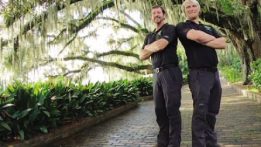Besides the panther, Florida’s other native wild cat is the bobcat, named for its short (or “bobbed”) tail. Weighing between 13 and 35 pounds, the bobcat has white on the underside of its tail and black on top, is grayish-brown, and sports a spotty coat. It also has white triangles on the back of its ears, likely so kittens can see their mothers in tall grass. The bobcat resides all over the continental United States and into southern Canada and northern Mexico. Its northern cousin is the Canada lynx, which is similar in appearance but larger and with pointy tufts on the top of its ears. Adult cats have excellent hearing and sight. Like most cats, they don’t like to swim but can if they really need to. Also, like our house cats, they can readily climb trees. The paw prints of a bobcat are very similar to a house cat’s—four rounded toes and no claws. Their claws are retractable unlike dogs’. You can distinguish between a bobcat print and “Fluffy’s” from the size of the print. Bobcat prints are about two inches wide while a house cat’s are about 1.5 inches. Bobcats grow to approximately 20’’ tall and prey on a wide variety of other animals, including rats, birds, rabbits, squirrels and even carrion (dead animals).
Bobcats are secretive and mainly active at dawn and dusk. They are generally territorial and normally use the same route to hunt for prey. Usually solitary, they use several methods to define their home range, such as scratching trees and spraying vegetation. When hunting, they keep on the move from dusk through midnight and may travel from two to seven miles. They are typically more active during the colder months and time their movements to those of their prey. To capture its meal, a bobcat will be still and wait for something to come by and then pounce on it with its claws. Although this species can go quite a while without food, when it does capture a larger animal, it will eat its fill and then carry the rest away to hide it and consume more later.
The bobcat’s breeding season is from winter to the following spring, and the female’s gestation period is about two months. Kittens are born fully furred and with spots but cannot open their eyes for several days. Up to four kittens will be born in the spring, and they will be able to look after themselves in about two months. Studies show less than half of the kittens will survive a full year in the wild, as they die from disease or starvation or are taken by larger predators.
Bobcats may live for up to 14 years in the wild but usually only make it to half that. The Florida population is doing quite well even with human development. They are very adaptable, and though they prefer the woods, they can even live in Florida’s agricultural and suburban areas. Local population sizes depend on what is available to eat. Present day threats to our bobcats include road strikes by cars and trucks and the destruction of their natural habitats. The poisoning of rats and mice may also kill bobcats, as the cat will consume the dead rodent and also be poisoned. Adult bobcats themselves are sometimes killed by coyotes.
Interestingly, our bobcat is thought to have evolved from the Eurasian lynx during the Pleistocene era. It arrived via the Bering Sea off Alaska when that waterway was frozen. In other words, this animal has been in North America for over 2.5 million years! Native Americans had many legends about bobcats, including a Nez Perce tale that depicted the bobcat and coyote as representing the opposite sides of nature. A burial mound in Illinois was found to contain a complete bobcat skeleton, and scientists believe it may have been kept as a pet!
To see a bobcat is a special treat, and the natural lands around Tallahassee are the place to look, especially at dawn or dusk. Go to our public lands, such as the St. Marks National Wildlife Refuge. Bobcats are very secretive and shy creatures, but you may be lucky and spot one. They have even been seen in town on rare occasions. ![]()
Preston Robertson
Florida Wildlife Federation
 Want to help Florida’s wildlife? Join Florida Wildlife Federation (FWF), floridawildlifefederation.org, (850) 656-7113. FWF is a Tallahassee-based non-profit organization that has been advocating for wildlife and wild places since 1936.
Want to help Florida’s wildlife? Join Florida Wildlife Federation (FWF), floridawildlifefederation.org, (850) 656-7113. FWF is a Tallahassee-based non-profit organization that has been advocating for wildlife and wild places since 1936.










